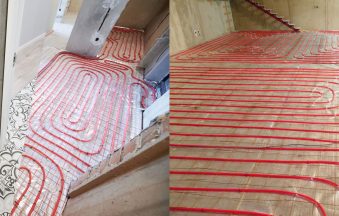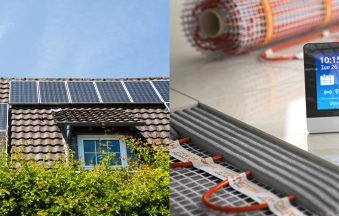How Underfloor Heating Can Reduce Your Energy Bills
In today’s climate of rising energy costs, homeowners are searching for innovative ways to reduce their energy bills while maintaining a comfortable home. Underfloor heating has emerged as a game-changing solution that not only delivers even, gentle warmth but also improves energy efficiency significantly. In this post, we explore how underfloor heating works, why it’s so efficient, and how it can lead to long-term savings on your energy bills.
What Is Underfloor Heating?
Underfloor heating is an advanced heating system installed beneath your flooring that radiates heat evenly across a room. There are two primary types:
Hydronic (Water-Based) Underfloor Heating:
Circulates warm water through a network of pipes beneath the floor. This system runs efficiently at lower temperatures, reducing energy consumption.Electric Underfloor Heating:
Uses electric cables or mats installed under the floor to convert electricity into heat. This option is particularly easy to retrofit in existing homes and is ideal for smaller areas.
Both types eliminate the need for bulky radiators, resulting in a cleaner aesthetic and a more evenly distributed heat throughout your home.
How Does Underfloor Heating Improve Energy Efficiency?
Even Heat Distribution
Unlike traditional radiators that concentrate heat in one area and rely on convection, underfloor heating emits radiant heat evenly across the entire floor. This consistent distribution means:
Lower Operating Temperatures:
Since the heat is spread uniformly, you don’t need to crank up the temperature. Even a modest increase in floor warmth can maintain comfort, saving energy over time.Reduced Heat Loss:
With no cold spots, your home retains warmth more efficiently, meaning less energy is wasted.
Lower Thermal Requirements
Underfloor heating systems are designed to operate at lower temperatures compared to conventional systems. Radiators often need temperatures of 65–70°C to warm a room effectively, whereas underfloor heating can achieve similar comfort levels at just 25–30°C. This lower temperature requirement translates directly into energy savings.
Zoning and Smart Controls
Modern underfloor heating systems are often equipped with smart thermostats and zoning controls. These features allow you to:
Heat Specific Zones:
Only warm rooms in use rather than heating the entire home.Optimise Heating Schedules:
Automatically adjust settings based on occupancy and weather conditions, ensuring energy is not wasted during times when you’re away.
How Underfloor Heating Reduces Your Energy Bills
Energy Consumption and Cost Savings
By operating at lower temperatures and distributing heat evenly, underfloor heating uses less energy to achieve the desired level of comfort. This efficiency can lead to a reduction in your overall energy consumption, which in turn lowers your energy bills over time.
Lower Running Costs:
Reduced energy usage means that even if the installation cost is slightly higher than traditional systems, the ongoing savings on your energy bills can quickly offset that initial expense.Long-Term Investment:
Although the upfront cost may be higher, many homeowners find that the energy savings over several years result in a favourable return on investment.
Compatibility with Renewable Energy
Underfloor heating systems work particularly well with renewable energy sources:
Solar Power:
Electric underfloor heating can be powered by solar panels, meaning your heating system could run on clean, renewable energy, further reducing your carbon footprint and energy costs.Geothermal Energy:
Hydronic systems can harness geothermal heat pumps, utilising the stable underground temperature to heat water efficiently.
Pairing underfloor heating with renewable energy not only lowers bills but also contributes to a sustainable, eco-friendly home.
Installation Considerations and Maintenance
Professional Installation
For maximum efficiency, it’s crucial to have your underfloor heating system professionally installed. A proper installation ensures that the system is perfectly integrated with your home’s insulation and flooring, which is key to reducing heat loss and achieving optimal energy savings.
Flooring Compatibility
The type of flooring you choose can impact the efficiency of your underfloor heating system. Materials with high thermal conductivity – such as tile, engineered wood, or certain luxury vinyl tiles (LVT) – allow heat to pass through easily, ensuring that your system performs at its best.
Regular Maintenance
Underfloor heating systems require minimal maintenance. However, regular inspections can ensure that the system operates efficiently over the long term, maintaining the energy savings you expect.
Real-World Examples and Case Studies
Many homeowners have already experienced the benefits of underfloor heating. For example:
Eco-Efficient Homes:
Several case studies show that homes equipped with hydronic underfloor heating powered by renewable sources have seen a significant drop in energy consumption – often reducing heating bills by up to 25%.Solar-Powered Systems:
Homeowners using solar panels to power their electric underfloor heating report lower monthly energy costs, especially during periods of abundant sunlight.
These real-world examples demonstrate that the initial investment in underfloor heating is quickly repaid through reduced energy bills.
Conclusion
Underfloor heating offers a sophisticated, energy-efficient solution for modern homes. By providing even, radiant heat at lower operating temperatures and integrating seamlessly with renewable energy sources, it significantly reduces energy consumption and lowers your energy bills. While the initial installation may require a larger investment, the long-term savings and enhanced comfort make underfloor heating a smart choice for both your wallet and the environment.
Are you ready to upgrade to a more efficient heating system? Contact a certified installer today to explore how underfloor heating can transform your home and reduce your energy bills.







